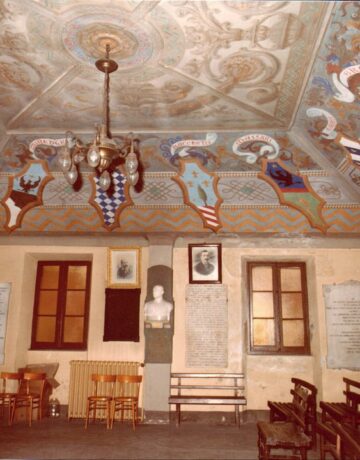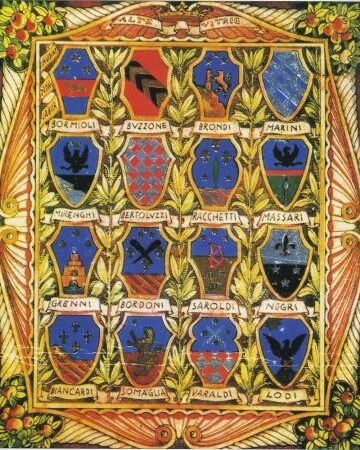Glass Art Museum: The Coats of Arms of the Glassmaking of Altare
 The coat of arms, which represents a privileged “status”, was assumed in the second half of the 16th century by the Altare glassmakers as they were part of an elite recognized by the Marquises Paleologo through the approval of the Statutes in 1512.
The coat of arms, which represents a privileged “status”, was assumed in the second half of the 16th century by the Altare glassmakers as they were part of an elite recognized by the Marquises Paleologo through the approval of the Statutes in 1512.
A heraldic description on each coat of arms, clarifies the symbolic meaning and the hermetic language that characterizes it. Some coats of arms show stars which could lead back to the noble elevation of the glassmaking art (on the flag of the guild dating back to the 16th century it is written “Alte Vitrie“). It is assumed that the lilies depicted on some of them, may be a tribute to the French monarchy by the families who operated in France in the 17th and 18th centuries.

All the coats of arms of the Altare glassmakers are “horse’s head”, a typical and ancient shape adopted in the Italian territory. Some of them are “truncated” or “split”, that is to say divided into two sectors by a horizontal line and no one is “ partito ” or vertically divided.
The coats of arms assumed by the sixteen families of glassmakers belonging to the Corporation, were painted on the ceiling of the Board of Directors Room (Sala del Consiglio di Amministrazione) of the S.A.V.
Fortunately, all of them were photographed before the building was abandoned and subsequently had fallen into disrepair with the collapse of the ceilings, so it was possible to reproduce them in an oil painting on the panel now exhibited in the Museum. These coats of arms are also engraved on the plaque which shows the names of the precursors and founders of the S.A.V.
Bibliography:
Aldo Saroldi, Blasonario delle famiglie vetrarie altaresi – una lettura iconografica, in Alte Vitrie (Blasonary of the Altar glassmaking families – an iconographic reading, in Alte Vitrie), year 10th – 11th , n. 3/98 – 1/99, pp. 6-10
